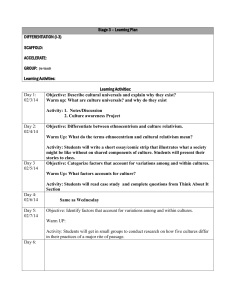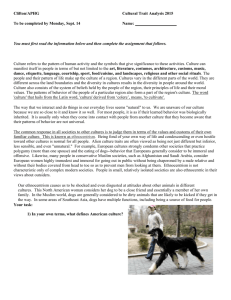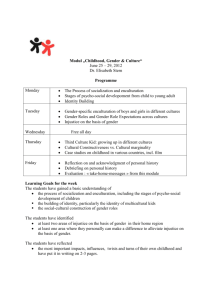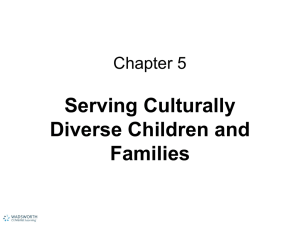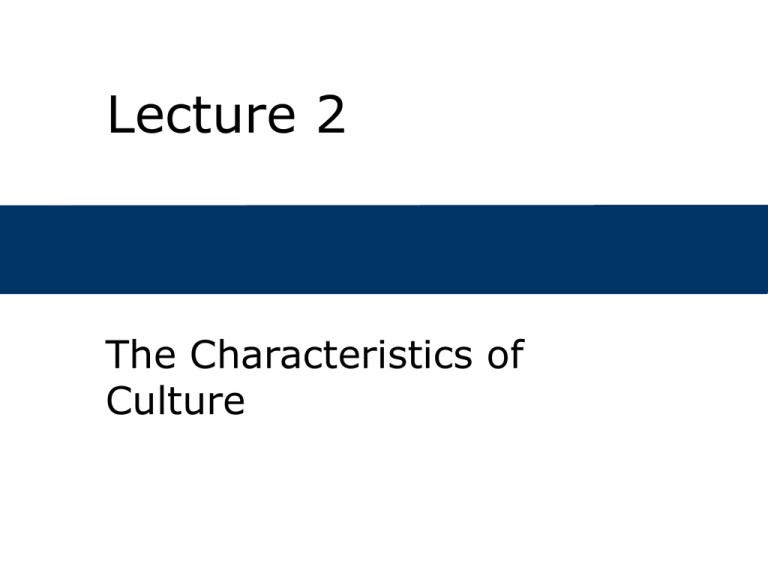
Lecture 2
The Characteristics of
Culture
Chapter Outline
What is culture?
How is culture studied?
Why do cultures exist?
The Concept of Culture (some definitions)
“one of the two or three most complicated words in the
English language” (R. Williams, 1976)
The sum total of knowledge, attitudes and habitual behavior
patterns shared and transmitted by the members of a
particular society. (Linton 1940)
All the historically created designs for living, explicit and
implicit, rational, irrational, and nonrational, which exist at
any given time as potential guides for the behavior of man.
(Kluckhohn and Kelly 1945)
The mass of learned and transmitted motor reactions, habits,
techniques, ideas, and values - and the behavior they induce.
(Kroeber 1948)
The man-made part of the environment. (Herskovits 1955)
“that complex whole which includes knowledge, belief, arts,
morals, law, custom, and any other capabilities and habits
acquired by man as a member of society” (Tylor 1871)
Characteristics Of Culture
Culture
Culture
Culture
Culture
is
is
is
is
shared.
learned.
based on symbols.
integrated.
Culture Is Shared
Culture cannot exist without society.
There are no known human societies
that do not exhibit culture.
All is not uniform within a culture;
There is some difference between men’s
and women’s roles in any human
society.
Culture Is Learned
All culture is learned rather than
biologically inherited.
The process of transmitting culture from
one generation to the next is called
enculturation.
Through enculturation individuals learn
the socially appropriate way to satisfy
biologically determined needs.
Culture Is Based on
Symbols
Culture is transmitted through ideas,
emotions, and desires expressed in
language.
Through language, humans transmit
culture from one generation to another.
Language makes it possible to learn
from cumulative, shared experience.
Culture Is Integrated
All aspects of a culture function as an
integrated whole.
A change in one part of a culture
usually will affect other parts.
A degree of harmony is necessary in
any properly functioning culture, but
complete harmony is not required.
Ethnic Groups of the
Russian Federation
Describing a Culture
Without Bias
Anthropologists must:
1. Examine people’s notion of the way
their society ought to function.
2. Determine how people think they
behave.
3. Compare these with how people
actually do behave.
The Barrel Model of
Culture
Functions of Culture
Provide for the production and
distribution of goods and services
necessary for life.
Provide for biological continuity through
the reproduction of its members.
Enculturate new members so that they
can become functioning adults.
Functions of Culture
Maintain order among members, as well
as between them and outsiders.
Motivate members to survive and
engage in those activities necessary for
survival.
Be able to change to remain adaptive
under changed conditions.
Why Cultures Change
Environment they must cope with has
changed.
Intrusion of outsiders.
Values have changed.
Evaluating a Culture
Cultures can be evaluated according to:
Nutritional status
Physical and mental health of
population
Incidence of violence, crime and
delinquency
Demographic structure
Stability and tranquility of domestic life
Glossary:
Adaptation - A process by which organisms achieve a
beneficial adjustment to an available environment; also the
results of that process the characteristics of organisms that fit
them to the particular set of conditions of the environment in
which they are generally found.
Cultural pluralism - Social and political interaction of people
with different ways of living and thinking within the same
society.
Culture - The values, beliefs, and perceptions of the world
shared by members of a society, that they use to interpret
experience and generate behavior, and that are reflected in their
behavior.
Enculturation - The process by which a society's culture is
passed from one generation to the next and individuals
become members of their society.
Ethnocentrism - The belief that the ways of one's own
culture are the only proper ones.
Ethnohistory -The study of cultures of the recent past
through oral histories; accounts left by explorers,
missionaries, and traders; and analysis of such records as land
titles, birth and death records, and other archival materials.
Ethnologist - An anthropologist who studies cultures from a
comparative or historical point of view, utilizing ethnographic
accounts.
Ethnoscientists - Anthropologists who seek to understand the
principles behind native idea systems and the ways those
principles inform a people about their environment and help
them survive.
Gender - The elaborations and meanings assigned by cultures
to the biological differentiation of the sexes.
Pluralistic societies - Societies in which there exist a diversity
of cultural patterns.
Social structure - The rule-governed relationships of
individuals and groups within a society that hold it together.
Society - A group of interdependent people who share a
common culture.
Subculture - A distinctive set of standards and behavior
patterns by which a group within a larger society operates.
Symbols - Sounds or gestures that stand for meanings among
a group of people.
Lecture 2 – QUIZ
1. Every culture teaches its members that there are
differences between people based on sex, age,
occupation, class, and ethnic group. People learn to
predict the behavior of people playing different roles
from their own. This means that
a.everyone plays the same role.
b.all cultures identify the same roles.
c.culture is shared even though everyone is not the same.
d.all cultures require that their participants play different
roles, even though that means that no one can predict
the behavior of others. e.everyone plays the same role
throughout their life.
2. Pluralistic societies
a.believe they are racially different.
b.have a diversity of cultural patterns.
c.are very rare in the world today.
d.are a hallmark of the civilized world.
e.none of these choices
3. The process by which culture is transmitted from one
generation to the next is
a.enculturation.
b.pluralism.
c.adaptation.
d.cultural relativism.
e.subcultural variation.
4. The __________ of culture is/are what a culture must do
to satisfy basic needs of its members.
a.functions
b.motivations
c.enculturations
d.integration
e.relativism
5. Which of the following statements is CORRECT?
a.Only some cultures change.
b.All cultures change at the same rate.
c.All culture change is disastrous.
d.Culture change can bring disastrous results.
e.all of these choices
6. _____________ refers to the position that because
cultures are unique, each one can be evaluated only
according to its own standards and values.
a.Ethnocentrism
b.Cultural relativism
c.Cultural materialism
d.Adaptation
e.Pluralism
7. _______________ is the notion that one's culture better
and more proper than other cultures.
a.Ethnocentrism
b.Cultural relativism
c.Cultural materialism
d.Adaptation
e.Pluralism
8. A ___________ society is one in which two or more
ethnic groups or nationalities are politically organized
into one territorial state but maintain their cultural
differences.
a.ethnocentric
b.diverse
c.pluralistic
d.acculturated
e.superstructure

